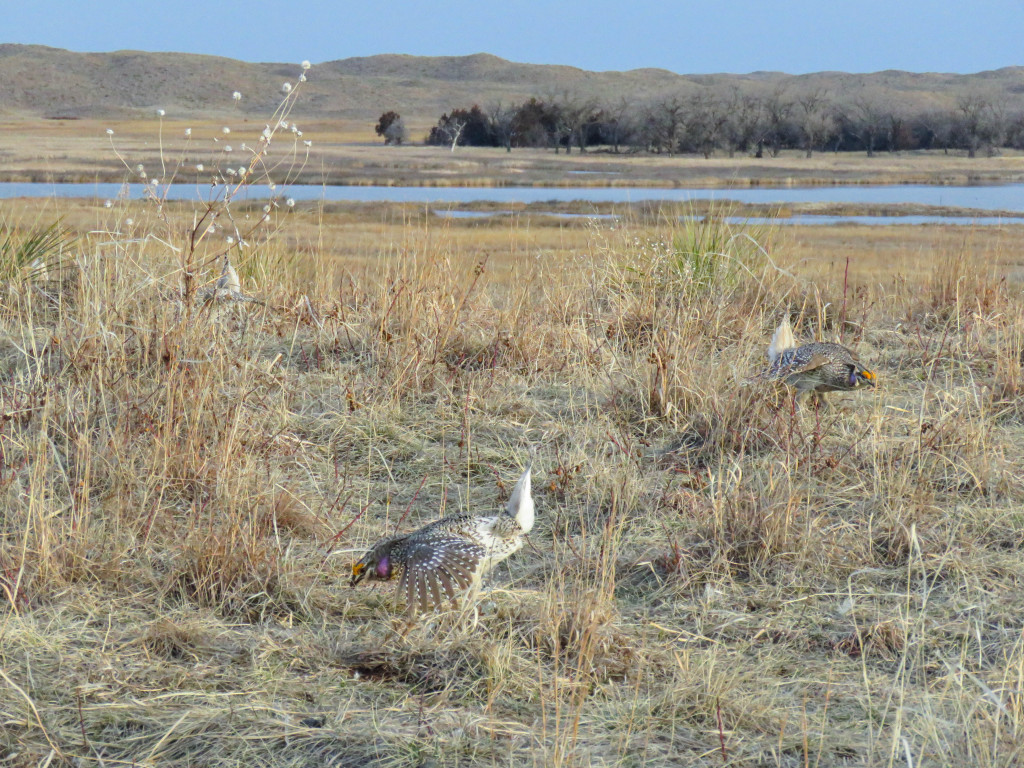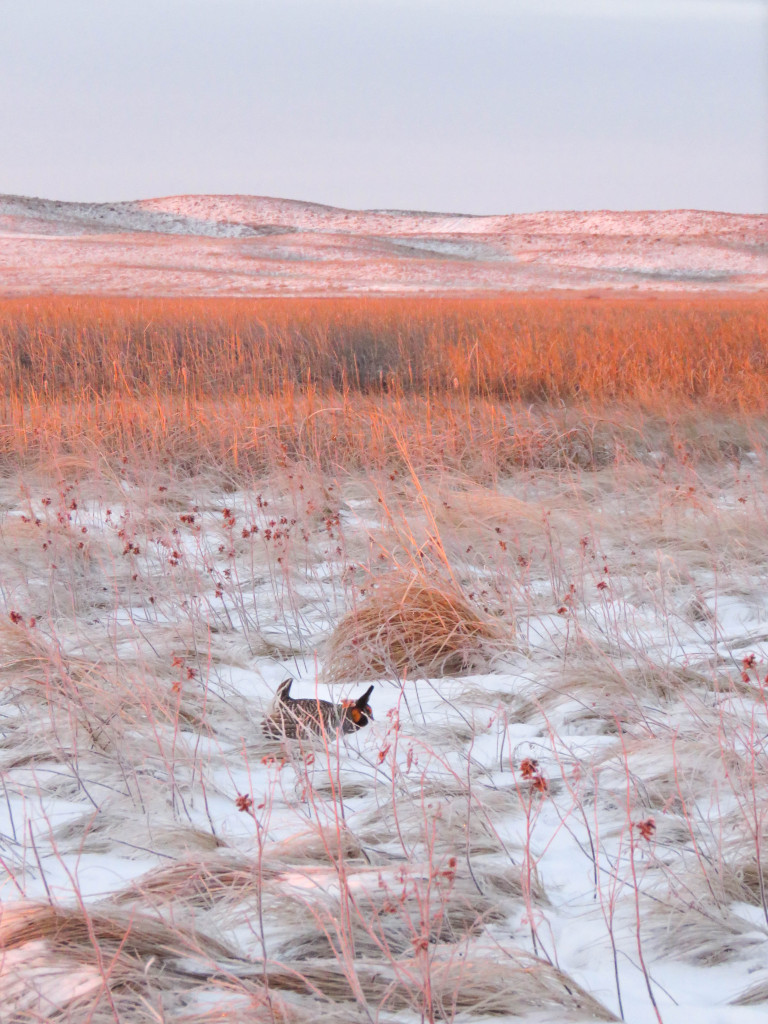
By Olivia DaRugna, Watchable Wildlife Biologist
The iconic greater prairie-chicken dances in Nebraska may only be second to the sandhill crane migration. Photos and art of the dancing chickens can be found on postcards, in shops and museums throughout the state, and it’s no surprise among those who have witnessed this natural phenomenon unfold before their eyes. One of Nebraska’s greatest spectacles goes something like this:
For most of the year, prairie grouse are inconspicuous in their prairie habitats across the state, but come mid-March through early May, the male birds are ready to perform. The dancing grounds, also known as leks, are where the males gather to impress the on-looking females.
Just as the morning darkness begins to lift, the male greater prairie-chickens begin their dance, quickly stomping their feet, raising their ear-like plumes, fanning their tails and inflating their bright orange air sacs to produce a low, booming vocalization. As the sun rises higher to set the landscape aglow, courtship dances are in full swing. A female making her way through the lek kicks the males’ dancing into high gear. Their vigorous performance sometimes includes a courtly bow to the nearby female, and competition can become fierce among males through a ritualized standoff, composed of whiny calls and cackles before jumping at each other with stuck out wings, feet or bills in a harmless manner.
Sharp-tailed grouse may not be as iconic as the greater prairie-chicken, but arguably, they have a more entertaining dance. The males almost synchronize their rapid stomping-pause-stomping footwork. You can barely tell their feet are moving with the quick stomping pace. All the while, they are showing off how pointed their tails are, holding their wings in a “M” shape, inflating their purple air sacs that resemble balloons on their throats and making barking chirps. Throw in a few graceful gliding movements around the lek site, and you get a show that can rival Dancing with the Stars.
There is nothing quite like watching a bunch of plump birds trying to impress the females. You might feel a bit colder while watching greater prairie-chickens or sharp-tailed grouse dance than watching your favorite dancing program on television, but I guarantee it is a much more memorable and enjoyable experience.
Where to view
In spring, prairie grouse can be observed at lek sites across the state. There are several free Greater Prairie-Chicken viewing blinds. Reservations are required for the blinds at Valentine National Wildlife Refuge and N-Corpe in North Platte.
The two viewing blinds at Burchard Lake Wildlife Management Area in Pawnee County are first come, first served.
For a fee, there are several guided viewing blind options, too. Free sharp-tailed grouse viewing blinds are available by reservation at Valentine and Crescent Lake National Wildlife refuges, and Oglala National Grassland near Crawford.
New this year is a viewing blind at Niobrara State Park, which was funded by the Watchable Wildlife Grants. After spending a night in one of the state park’s cozy cabins overlooking the beautiful Missouri River, wake up early for a brief commute to the sharp-tailed grouse blind. Visitors to this blind have enjoyed the surprising visit of greater-prairie chickens to this grouse lek, giving them a two for one deal.
Viewing etiquette and tips
For the safety of the birds and to provide the most enjoyable and uninterrupted viewing opportunities for yourself and others, follow these tips and viewing ethics.
- Arrive early, about 45 minutes before the sun rises. Walking to a viewing blind in the dark can be tricky. It’s helpful to visit the viewing blind during the afternoon prior to your morning in the blind. This way, you have an idea of where the blind is and how far the hike might be. In the morning, bring a headlamp or flashlight to help you find your way to the blinds before sunrise.
- Dress warm and bring layers! Sitting in a blind in the early morning can be very chilly. Hand and feet warmers are always a bonus.
- Stay quiet, and don’t forget to turn off cell phone ringers.
- Avoid using flash photography, which can scare the birds away.
If you get the chance to view prairie grouse when there is a dusting of snow on the ground, it makes for incredible photos with the contrasting orange or purple airsacs against the brilliant white snow.

Upcoming wildlife viewing events
Here are a couple events to look out for this month.
City Nature Challenge, April 28 – May 1
This is a global event to find and document urban wildlife. Several cities across Nebraska will be hosting free family-friendly events, but you can participate no matter where you live in the state. Click here to learn more.
Nebraska Birding Bowl, Registration opens in April.
Register your team for this free, statewide birding event that takes place the entire month of May for Nebraska Bird Month. This fun and friendly competition is for all skills levels, from beginning birders, to backyard birders, to competitive listers. Participation is easy! To learn more and to register, visit: https://birdtrail.outdoornebraska.gov/birdingbowl/
